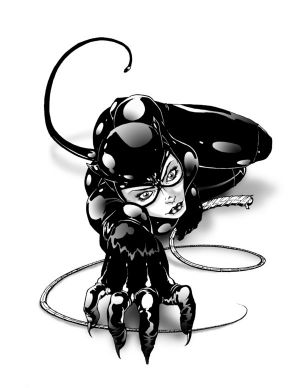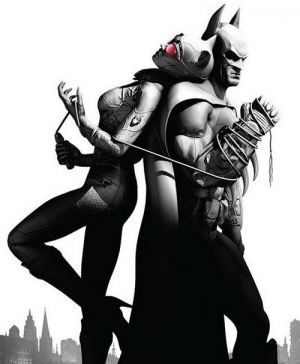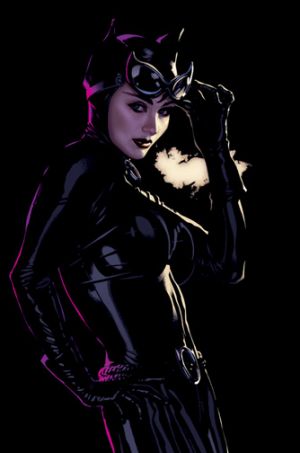Queer Comics
Catwoman: Honorary Sister of Sappho
By J. Skyler
September 6, 2012 - 07:09
The Greek poet Sappho, whose work often spoke of admiration, beauty and love for women, is an iconic figure in the lesbian community; the word “lesbian” itself is derived from her birthplace, the Isle of Lesbos, while the terms "sapphic" and "sapphism" have become synonymous with same-sex attraction between women. The term “gay icon”, although meant to reflect people iconic to the entire Lesbian, Gay, Bisexual and Transgender (LGBT) community, focuses disproportionately on public figures prolific among gay men. Some men, including James Dean, Marlon Brando and Johnny Cash have been identified as lesbian icons, but I’d rather examine what makes a woman iconic to the lesbian community. In Ginette Vincendeau’s Stars and Stardom in French Cinema (2000), the author writes that actress Catherine Deneuve’s performance in The Hunger (1983) depicts a “cool unattainability, according to The Advocate, [which] echoed longings in the audience, especially a lesbian audience. But it is clear also that Deneuve’s mature star persona—she was exactly forty when she appeared in the film—enabled her to portray a seducer in charge of her desires who nonetheless remained a traditionally glamorous feminine figure in appearance.” In contrast, historical figures, such as Anne, Queen of Great Britain and Marie Antoinette have been rumored to be lesbians, usually to their public detriment or as literary reimagining. If the qualifications of a lesbian icon involve powerful women (or women in positions of power), whose dubious or sorted reputations precede them, and yet, remain visions of mature sexuality and classic femininity, only one name in the world of fiction comes to mind: Catwoman.
Women often face a daunting task of challenging cultural roles during their lifetime. All women at some point or another challenge their father’s ideal of the perfect daughter (which often contrasts sharply with the ideal of the perfect son), but as they grow into adulthood, heterosexual women (and bisexual women in heterosexual relationships) must also challenge men’s preconceptions of the perfect girlfriend or the perfect wife. Lesbians, however (or bisexual women in same-sex relationships), have the liberty of defining themselves without the influence of an idealized male fantasy. In fiction, same-sex relations among women are often depicted though a lesbian utopia—a female-only society in which men are absent (such as those inspired by the myth of the Greek Amazons) or a type of post-apocalyptic setting where only the female of the species has survived. Metaphorically, it is not necessarily a matter of demonizing men, but rather questioning how women perceive themselves without the objectifying male gaze. As Jane Donawerth observes in Frankenstein's Daughters: Women Writing Science Fiction (1997), “[t]he lesbian utopia has been frequently condemned by critics for its essentialism, while it has not been recognized that its purpose is not to exclude men, but simply to establish a safe place for lesbian pleasure.” Thus, if the exploration of lesbian sexuality and identity in fiction is based on a woman’s need for self-determination, the self-reliant and self-indulgent characterization of Catwoman is a perfect role model.
Catwoman’s characterization, written outside of the normative definitions of morality and femininity, is emphasized through her depiction as an outlaw. In her seventy-two years in publication, Catwoman’s characterization has evolved from villainy to amorality to antiheroism. M. Keith Booker states in the Encyclopedia of Comic Books and Graphic Novels (2010) that “[i]n 1993, her continued popularity led DC Comics to publish Catwoman, an ongoing series depicting Selina Kyle as an international thief with an ambiguous moral code. In 2001, a new Catwoman series was launched that showcased Kyle as both a cat burglar and the protector of Gotham’s East End.” Furthermore, Girl Culture: Studying Girl Culture: A Readers' Guide (2008) notes that “[a]s the series progresses, Catwoman becomes a Robin Hood of sorts, as she steals from the rich and gives to the poor.” Never quite in tune with the law, her existence in the DC Comics Universe is analogous to the evolution of Gay Liberation in the United States. LGBT people have come from the stigma of mental illness and pedophilia in the 1950s and 1906s, to begrudging social recognition of our disenfranchisement in the 1970s and 1980s, to the edge of full equality under law in the past decade. Like Catwoman, however, LGBT people have yet to be full accepted as “decent” human beings.
Author Cheshire Calhoun documents in Feminism, the Family, and the Politics of the Closet: Lesbian and Gay Displacement (2000) that “[w]hile racial and gender discrimination are largely predicated on inferiorizing stereotypes, sexuality discrimination is largely predicated on immoralizing stereotypes whose ultimate suggestion is not that gay men and lesbians are incompetent, but that they are untrustworthy members of civil society… Unlike their presumed innocent and civic-minded heterosexual counterparts, they cannot represent themselves as gay men or lesbians without undermining their standing in the public sphere.” If we take Batman as an analogy of the “presumed innocence” of heterosexuality in the same way we may view the “untrustworthy” Catwoman as an analogy for lesbianism, their adversarial relationship exemplifies the notion that heterosexuality (Batman) is superior to homosexuality (Catwoman) even though both are natural expressions of human sexuality and in over 450 species in the natural world according to Biological Exuberance: Animal Homosexuality and Natural Diversity (2000), including *gasp* cats; Batman’s continued attempts to “reform” Catwoman’s criminal behavior—despite being legally recognized as a criminal himself—are reflexive of the Ex-Gay rhetoric that homosexuality can be “cured” through conversion therapy, despite such practice being labeled dangerous and fundamentally flawed by the American Psychological Association and American Psychiatric Association. Arguments on their personal motivations aside, from the standpoint of a District Attorney’s Office, both Batman and Catwoman deserve incarceration—one form of lawlessness (sexuality) is not superior to the other.
Gladys L. Knight states in Female Action Heroes: A Guide to Women in Comics, Video Games, Film, and Television (2010) “[a]s a symbol of second-wave feminism, Catwoman idealizes independence and female empowerment, but she also takes pleasure in her own objectification.” She is one of the most overtly sexual women in fiction, but she is also the center of her own eroticism. Her sexuality is not defined by, nor dependent upon the approval of Batman or any other male character. She is raw, unbridled, and quite frankly, she’ll get off whether you’re enthralled by her or appalled. Objectively, she defines all cultural norms of women’s sexuality—she is not passive, she is not submissive, and she does not tailor her attitude to fulfill a man’s desires. However, despite her aggressive and autocratic nature, her physique, demeanor and mannerisms still embody classic ideals of femininity—a voluptuous body, sultry voice, as well as graceful and fluid movements. She is the ultimate seductress, because she can warp a man into believing that her desires and objectives are actually his own.
Although undoubtedly a symbol of feminist ideology, I would re-categorize Catwoman as a reflection of third-wave feminism. As Leslie Heywood states in Third Wave Agenda: Being Feminist, Doing Feminism (1997), “[d]uring the second wave feminist movement, lesbians, women of color, and/or poor and working-class women were often excluded by the movement's largely heterosexual, white, middle-class focus.” Lesbians and bisexual women fought their way into the conversation concerning Women’s Liberation and Gay Liberation, facing double jeopardy by battling preconceived notions about gender and sexuality simultaneously. Having been depicted as a runaway and as a prostitute, Catwoman’s character history reflects the impoverished class advocacy of third-wave feminism, in addition to the argument that sexuality cannot be evaluated on an all-or-nothing moral gage; a tenant of the third-wave, in addition to an outspoken inclusiveness regarding same-sex attraction and transgender identification, is that sex work—including prostitution and pornography—are not inherently oppressive or objectifying to women, but can also be a valid expression of women’s sexuality. Melissa Hope Ditmore observes in Prostitution and Sex Work (2011) that “some feminists have accused sex workers who defend their work of false consciousness regarding their own oppression and exploitation. This perspective is patronizing to all women in that it suggests that some women do not know what is good for them… Feminism increasingly recognizes sex workers' rights to control their bodies, including the choice to work or not to work in the sex industry, as sex workers insist on participating in the discussions of sex work and related policies.” To put the argument into perspective, there is a radical difference in someone such as Jenna Jameson (with an estimated net-worth of over $30 million dollars) choosing to work in adult film versus adults and/or adolescent minors forced into sexual slavery as victims of human trafficking, which is a $3 billion dollar a year criminal industry. While Barbara Gordon’s Batgirl represents the philosophically idealist virtue of second-wave feminism—equality in education, the workforce and reforming legal inequalities concerning women—Selena Kyle’s Catwoman embodies the philosophically realist sex-positive arguments of third-wave feminism, in that she defines her sexual morality as an individual rather than according to a universal standard. The adversarial relationship between Batgirl and Catwoman can be seen as the clash of the Feminist Sex Wars, when second and third-wave feminists fiercely debated the moral boundaries of sex. Encyclopedia of Gender and Society, Volume 1 (2008) explains that the Sex Wars placed sexuality “in the categories of pleasure versus danger, victimization versus liberation—all of which reduced power to a negative and divided the feminist movement into two opposing camps.”
Even in the light of pleasure and liberation, danger and victimization will always be a concern in discourse on women's sexuality. The threat of rape—whether my family members, by lovers or by strangers—is another reason lesbians, and all women regardless of orientation, have strived to define their sexuality on their own terms. The crime of “corrective rape” in particular is a matter of extreme concern for lesbians and bisexual women. Volume 1 in Encyclopedia of Women in Today's World (2011) documents that “[i]f a woman is suspected of being gay or openly lesbian there is an attempt to ‘fix’ the problem by raping her. Sometimes mutilation and or murder follow the incident.” The leather-clad Catwoman can be seen as the “feminist avenger”, punishing and even executing criminals whose actions are partial or entirely misogynistic. Jacinda Read reiterates in The New Avengers: Feminism, Femininity and the Rape-Revenge Cycle (2000) that “[a]s Naomi Wolf has observed, Catwoman’s suit is ‘a second skin that cannot be raped, a manifestation of women’s longing to be absolutely sexual but absolutely inviolable’.” Her seeming invincibility is what has set her apart from other female fictional characters, whose sexuality is often, if not always, deemed exploitative. If you haven’t had the fortune of watching the animated short DC Showcase: Catwoman (2011), my heart bleeds for you, because you are missing out on quite literally the best depiction of Catwoman ever. The short film is a mere fifteen minutes, but its execution, exquisitely voiced by Eliza Dushku, rivals (and dare I say surpasses) portrayals by Michelle Pfeiffer and Anne Hathaway. The action-packed drama shows a brief strip-tease by Catwoman—one of the most erotic displays I’ve ever encountered in any media—but I never doubted for a second that she was in absolute control of the situation (and enjoyed every second of it), despite her antagonist and his cohorts believing themselves to be without equal.
DC Showcase: Catwoman also displays the characters’ affinity for the young Holly Robinson, who first appeared in Frank Miller’s graphic novel Batman: Year One in 1987 (as well as the animated adaptation of the same name in 2011). Catwoman is cemented as a lesbian ally through her relationship with Robinson, who is revealed to be a lesbian in the relaunched Catwoman comic book series in 2002. Guardian, friend and mentor, Catwoman trains Robinson in the martial arts and following DC Comics’ company-wide event One Year Later (2006), requests that she take her place as Catwoman after giving birth to a daughter. Thus, for a brief period in time, Catwoman is literally depicted as a lesbian. Although her time as Catwoman is short-lived, Robinson remains a fan-favorite. Selena Kyle eventually took back her mantle and continues to star in her own monthly title as part of The New 52. The ultimate seductress, unbridled feminist avenger, and lesbian ally, Catwoman is assuredly one of DC Comics’ greatest icons and more than worthy of being an honorary ‘Sister of Sappho’.
Follow me on Twitter @jskylerinc
Related Articles:
Review: Catwoman #1-6
Catwoman Tweety & Silvester #1
Catwoman #1
Catwoman #14 Review
Catwoman: Honorary Sister of Sappho
Catwoman #1
Catwoman #1 Review
Batman Arkham City Catwoman Trailer
Catwoman Lives Past 81
Ame-Comi Catwoman, Better Late than Never




